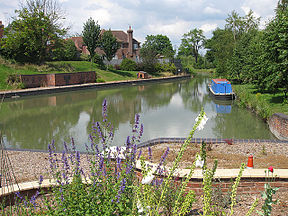Hereford and Gloucester Canal
| Herefordshire and Gloucestershire Canal | |
|---|---|

The restored basin at Over
|
|
| Specifications | |
| Maximum boat length | 70 ft 0 in (21.34 m) |
| Maximum boat beam | 8 ft 0 in (2.44 m) |
| Locks | 23 |
| Status | Several sections under restoration |
| Navigation authority | none |
| History | |
| Original owner | Herefordshire and Gloucestershire Navigation Co |
| Principal engineer | Josiah Clowes |
| Other engineer(s) | Robert Whitworth, Stephen Ballard |
| Date of act | 1791 |
| Date of first use | 1798 |
| Date completed | 1845 |
| Date closed | 1881 |
| Geography | |
| Start point | Over, nr Gloucester |
| End point | Barrs Court Basin, Hereford |
| Branch(es) | Oxenhall Coal Branch |
| Connects to | River Severn |
The Herefordshire and Gloucestershire Canal (sometimes known as the Hereford and Gloucester Canal) is a canal in the west of England, which ran from Hereford to Gloucester, where it linked to the River Severn. It was opened in two phases in 1798 and 1845, and closed in 1881, when the southern section was used for the course of the Ledbury and Gloucester Railway. It is the subject of an active restoration scheme.
The first plans for a canal between Hereford and Gloucester were made by Robert Whitworth, one of James Brindley's pupils, in 1777. The route was part of a grander plan to link Stourport on Severn and Leominster as well. Twelve years later, Richard Hall submitted plans for a canal via Ledbury. In March 1790, the promoters decided to submit the plans to Parliament. Josiah Clowes, an engineer who had previous experience of working on the Chester Canal and who had worked with Whitworth on the Thames and Severn Canal, was to be the engineer. It appears that he re-surveyed the route, and recommended a change, so that it passed through Ledbury. A branch would be built to Newent where there were minor coalfields, and the canal would be suitable for boats 70 by 8 feet (21.3 by 2.4 m), capable of carrying 35 tons. The estimated cost was £70,000, and it was expected to carry 33,203 tons per year, generating £9,582 in revenue. Some of the promoters began to think that improving the River Wye might be a better option, but the announcement of new seams of coal at Newent resulted in a decision to obtain an Act of Parliament, which was granted in April 1791.
Hugh Henshall, who was the brother-in-law of James Brindley, was asked to re-survey the route in 1792, and recommended a diversion to Newent. This route required a tunnel at Oxenhall, and another act of parliament was obtained in 1793 to sanction the new route. Josiah Clowes died in 1795, and was succeeded as engineer by Robert Whitworth. By late 1795, the initial section was open to Newent, but the tunnel was causing major problems.
...
Wikipedia
